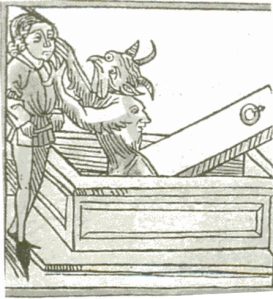The ensuing paragraph described a man named Arnold Paul who had felt himself tormented by vampires, then after his death was deemed to have become a vampire himself.
Having found the man’s body too well preserved in the grave, his neighbors, “according to Custom, drove a Stake thro’ his Heart; at which he gave a horrid Groan. They burnt his Body to Ashes, and threw them into his Grave.” And to be safe, the people “served several other dead Bodies in the same manner.”
That article was widely reprinted and discussed in Europe. I’ve found only two American periodicals that picked it up, however: the Weekly Rehearsal of Boston on 5 June 1732 and the American Weekly Mercury in Philadelphia on 15 June 1732. Both stories ran on page 2, and no follow-up discussions appeared on this side of the Atlantic.
In October 1736 the French magazine Mercure Historique et Politique published a vampire report from Moldavia in eastern Europe. That news was translated into English within months, but it took another year before the New-England Weekly Journal of 14 Mar 1738 reprinted the tale. That two-page periodical promised “the Most Remarkable Occurrences Foreign and Domestick,” and its printers ran this story at the top of page 1.
In this incident, after several deaths a village came to suspect a vampire was lurking nearby. Imperial authorities exhumed several bodies and found one unusually well preserved. They “drove a Stake through his Heart, which done, a great Fire was kindled, and the Carcase reduced to Ashes.” Again, there was no follow-up in the Boston press.
On 21 Jan 1765, the Connecticut Courant of Hartford published a front-page article headed “The surprizing Account of those Spectres called VAMPYRES.” That newspaper stated:
These Vampyres are supposed to be the bodies of deceased persons animated by evil spirits, which come out of their graves in the night-time, suck the blood of many of the living, and thereby destroy them. Such a notion will probably, be look’d upon as fabulous: but it is related and maintained by authors of great authority.The item then quoted “M. J. Henr Zopfius” as saying that a stake through the heart and a bonfire could solve the problem. The article noted a number of examples from 1693 through 1738 before closing with citations of Biblical verses.
That whole passage came right from The Travels of three English Gentlemen, from Venice to Hamburgh, being the grand Tour of Germany, in the Year 1734. It was inspired by a conversation those three travelers had in Laubach, Hesse, followed by some library research. This anonymous text was first published in the fourth volume of The Harleian Miscellany, a collection of manuscripts, pamphlets, and tracts from the Earl of Oxford’s library edited by Dr. Samuel Johnson and published in 1745.
In other words, this report wasn’t timely, useful information. Printer Thomas Green used a sensational old story to attract eyeballs. The next item in that issue of the Courant was “A comical MIRACLE” about a dug-up skull that fooled some French Catholics.
I’ve found only one American newspaper picking up the “surprizing Account” from the Connecticut Courant (or a common source). That was the 1 Apr 1765 Boston Evening-Post, and that date might be significant. Again, the Fleet brothers chose to run the as the first item in the issue. But this publication attracted a quick pushback.
TOMORROW: Wonders of the invisible world indeed.

I'm thinking you are going to mention this https://www.smithsonianmag.com/history/the-great-new-england-vampire-panic-36482878/
ReplyDeleteEven better is to hear the talk on the discovery of the CT vampire burials https://www.youtube.com/watch?v=jiCKJBHdNgo
Given that we do not go routinely digging up burial grounds, one wonders how many of these burials there really are.
I started with Nick Bellantoni's excavation in Connecticut on Friday. The S.H.E.A.R. panel discussed there was about the historical roots of the vampire exhumations in New England. Why in this region of all parts of America?
ReplyDelete